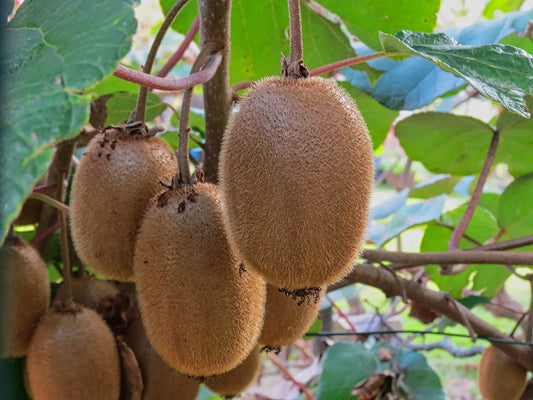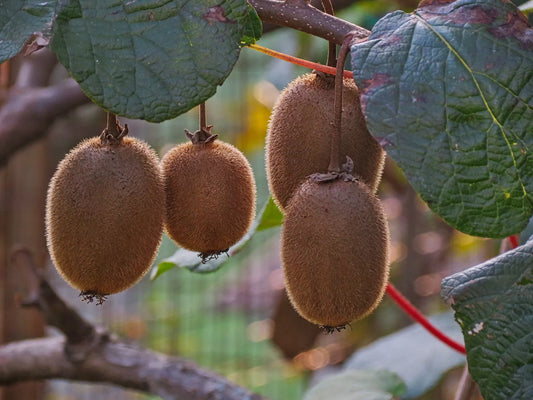-
Delivery from 10 plants to France, Switzerland and Europe
-
Kiwi Plants Wholesale Supplier
-
Quality Kiwi Plants
-
Secure payment - 3X payment
Our Tomuri Kiwi plants for professional Kiwi growers
The prices shown are our base prices for large volumes. Depending on the quantity ordered and the producers’ pricing scales, the rate may be adjusted upward. Each quote is personalized to ensure you receive a fair price.
-
Kiwi Tomuri plant franc - 45-cell tray of 4 conventional
Regular price €1,50 EURRegular price -
Organic Male KIWI Tomuri Plant - 77-piece 3.5cm root ball tray
Regular price €2,38 EURRegular price -
Organic Male KIWI Tomuri Plant - Box of 10 1.5L Pots
Regular price €6,25 EURRegular price -
Kiwi Tomuri plant - bare-root 1 year old diameter 8+ conventional
Regular price €8,00 EURRegular price -
Kiwi Tomuri plant franc - 2.5 Liter pot (13X13X18) conventional
Regular price €8,50 EURRegular price -
Kiwi Tomuri plant - bare-root 1 year old diameter 10+ conventional
Regular price €9,00 EURRegular price -
Kiwi Tomuri plant - bare-root 1 year old diameter 12+ conventional
Regular price €9,40 EURRegular price -
Tomuri kiwi grafted on Bounty 71 - 1 year old conventional bare-root
Regular price €11,00 EURRegular price -
Tomuri kiwi grafted onto Roki - 1 year old conventional bare-root
Regular price €11,00 EURRegular price
Collapsible content
When to Plant? When to Harvest? - Growing Guide / Diseases / Pests
You can find all our planting advice for kiwis in France here.
How profitable is kiwi production in France?
Planting / Harvesting Calendar:
Kiwi Planting and Harvesting Calendar
Production schedule for a one-hectare plot of kiwi
Self-fertile / Male Female
What is a self-fertile plant? Our self-fertile kiwi plants
What is a Male/Female plant? Our Male/Female Kiwi plants (Dioecious plants)
Kiwi Pollination - How to Promote It?
Free Plants, Grafted Plants, Rootstocks:
Kiwi - Rootstock or Free Plants: How to Choose?
Kiwi Rootstock Comparison: Bounty 71 vs Roki
Kiwi Grafting Techniques for Professionals
Plot layout / Planting technique
T-bar Method: The T-bar Method: A Complete Guide to Planting Kiwis in France
Pergola Method: The Pergola Method: A Complete Guide to Planting Kiwis in France
Fertilization / manuring of kiwi from planting to production
Kiwi Bud Break - Guide to Successful Kiwi Bud Break
Lignification - Optimizing lignification / Heightening of kiwis
Kiwi Pruning - How to Optimize Kiwi Pruning in France for Exceptional Fruit Production
Kiwi Plants In Vitro - Micro Propagation of Kiwi Plants
Kiwi - Thinning Kiwis. Why and When to Do It?
When and how to harvest kiwis?
Irrigation / Antifreeze System
Kiwi Irrigation - Water Needs of Kiwi Farms in Southern France
Antifreeze System - Antifreeze spray for kiwis: an essential solution for professional producers
Diseases that can affect kiwi crops in France
Fighting Kiwi Bacterial Canker: Symptoms, Prevention, and Professional Solutions
Fighting Kiwi Botrytis: Symptoms, Prevention and Professional Solutions
Fighting Kiwi Phytophthora: Symptoms, Prevention and Professional Solutions
Fighting Sooty Leaf and Fly Dropping Disease in Kiwi Crops: Symptoms, Prevention and Professional Solutions
Fighting Kiwi Scab: Symptoms, Prevention and Professional Solutions
Fighting Kiwi Anthracnose: Symptoms, Prevention and Professional Solutions
Fighting Kiwi Chlorosis: Symptoms, Prevention and Professional Solutions
Fighting Phaeomoniella in Kiwis: Symptoms, Prevention and Professional Solutions
Pests that can affect kiwi crops in France
Fighting the Kiwi Brown Stink Bug: Symptoms, Prevention and Professional Solutions
Fighting Kiwi Mealybug: Symptoms, Prevention and Professional Solutions
Fighting the Voracious Kiwi Mealybug: Symptoms, Prevention and Professional Solutions
Fighting the Kiwi Leafhopper: Symptoms, Prevention and Professional Solutions
Fighting Kiwi Thrips: Symptoms, Prevention and Professional Solutions
Controlling Root Knot Nematodes in Kiwi: Symptoms, Prevention and Professional Solutions
Collection: Our Tomuri Kiwi plants for professional Kiwi growers
Tomuri Kiwi Technical Sheet:
Economic considerations
- Average yield in kg per tree: The Tomuri kiwi, being a male variety, does not produce fruit. Its main function is to pollinate female varieties, such as the Hayward kiwi.
- Recommended Commercial Use: Tomuri kiwifruit has no direct commercial use, but it is essential for the fruit production of female varieties as a pollinator. It is therefore sought after by professional kiwifruit growers.
Plant characteristics
- Mature size of the tree: 4 to 5 meters in height and 4 to 6 meters in span, reaching up to 10 meters.
- Vigor and habit: Very vigorous with a climbing habit.
- Need for staking: Yes, solid support required (stake, wire mesh) to support the branches and allow good training.
- Longevity: 50 to 100 years.
- Earliness: Used to pollinate female varieties like Hayward.
- Fruiting period: No fruiting, but pollinates female varieties whose fruits are harvested from October to November.
- Self-fertility: Not self-fertile, essential for pollination of females.
- Recommended Pollinators: Tomuri kiwi is itself a pollinator and can pollinate up to 5 to 8 female kiwi plants, such as the Hayward variety.
- Disease resistance: Good disease resistance.
- Pest resistance: Low susceptibility to insects and diseases, but may be affected by red mites.
- Drought resistance: Adaptable to medium drought conditions with frequent watering in summer.
- Sensitivity to limestone: Prefers rich, drained soils with little limestone.
- Susceptibility to root asphyxiation: Not specifically mentioned, but requires good planting depth and sufficient root space.
Optimize Your Orchards with Tomuri Kiwi: The Essential Pollinator
The Tomuri kiwi is much more than just a male variety; it's a key element in kiwi production in France. As an ideal pollinator for female varieties, such as the famous Hayward kiwi, it guarantees abundant harvests of exceptional quality. If you are looking to buy Tomuri kiwi plants to maximize your production, trust Kiwiverse, a specialist wholesale supplier of kiwi plants, to support you in your project.
Tomuri Kiwi: The Ideal Partner for Kiwi Production
Why is Tomuri essential?
Tomuri, although it doesn't produce fruit, is essential in any kiwifruit orchard. Here's why:
- Prolific Pollination: With its flowers rich in high-quality pollen, one Tomuri plant can pollinate up to eight female plants.
- Universal compatibility: Particularly effective for Hayward kiwi, it can also be adapted to other varieties.
- Hardiness and adaptability: Able to withstand extreme temperatures down to -20°C, it thrives in various French regions.
To ensure successful pollination and optimal yields, purchase your Tomuri kiwi plants today from Kiwiverse.
Botanical and Agronomic Characteristics of Tomuri Kiwi
A Vigorous and Climbing Plant
The Tomuri kiwi is a vigorous, fast-growing variety. Its climbing branches easily reach 4 to 6 meters, requiring sturdy training to guide and support its growth.
Lush and Exotic Foliage
Its bright green deciduous foliage adds a decorative touch to the orchard. Its fragrant white flowers attract both natural pollinators and admiring glances.
Flowering and Pollen
Tomuri flowers in mid-June, producing an abundance of high-quality pollen. This ensures optimal fertilization of the female varieties and premium fruit.
Cultural Requirements: Promote Optimal Growth and Pollination
Soil and Nutrition
- Soil Type: Tomuri prefers rich, well-drained, slightly acidic soils (pH 6 to 6.5).
- Nutrition: Adding compost in the spring and organic fertilizer will strengthen its vigor and increase the quality of the pollen.
Exposure and Irrigation
- Sunshine: Full sun exposure stimulates flowering.
- Irrigation: Although tolerant of periods of drought, Tomuri thrives with soil kept moist, especially in summer.
Trellising: An Essential Structure
Given its vigor, training is essential. Install a pergola or trellis to contain growth and facilitate pruning and pollen collection.
Need technical support? Kiwiverse, your kiwi farming expert, offers tailored advice for designing and managing your orchard.
Agronomic and Commercial Benefits of Tomuri Kiwi
An Asset for Professional Producers
By integrating Tomuri into your orchard, you benefit from numerous advantages:
- Improved yields: Its prolific pollination guarantees optimal fruiting of female varieties.
- Exceptional durability: A Tomuri plant can produce pollen for 50 to 100 years, providing a long-lasting investment for your orchards.
Climate Adaptability
Its hardiness makes it an ally of choice for French regions with harsh winters.
Natural Resistance
Not very susceptible to common diseases, Tomuri requires special attention for pests, especially red mites.
Tomuri Kiwi Pruning and Care
Production Size
To maintain abundant flowering and controlled growth:
- At the end of winter, prune the previous year's branches to encourage flowering branches.
- In summer, remove invasive branches to concentrate energy on flowering.
Amendment and Care
An annual addition of compost or manure will enrich the soil and promote healthy growth.
Commercial and Ornamental Applications
For Productive Orchards
Tomuri is the mainstay of kiwifruit production, ensuring quality harvests through efficient pollination.
An Ornamental Role
Its lush foliage and climbing growth also make it an aesthetic choice for pergolas and trellises.
With Kiwiverse, enjoy fast delivery of professional-quality plants directly to your farm.
Key Points to Remember about Kiwi Tomuri
- Prolific pollination: One plant can cover up to eight female plants.
- Exceptional hardiness: Resists temperatures down to -20°C.
- Sustainability: Pollen production that can last for several decades.
- Necessary training: A structuring system is essential to guide its vigorous growth.
FAQs
- What is the main function of the Tomuri Kiwi? The Tomuri Kiwi is a male variety used for pollinating female varieties, such as the Hayward.
- How many female plants can a Tomuri plant pollinate? A Tomuri plant can effectively pollinate between 5 and 8 female plants.
- Can the Tomuri kiwi produce fruit? No, the Tomuri does not produce fruit. It is exclusively used for pollen production.
- How long does a Tomuri plant live? With good care, a Tomuri plant can produce for 50 to 100 years.
- What are the specific soil requirements for Tomuri Kiwi? Tomuri prefers well-drained, rich, and slightly acidic soil (pH 6 to 6.5).
- How to care for a Tomuri plant? Regular pruning, annual addition of compost, and strong training are essential for optimal growth.
Conclusion
The Tomuri kiwi is the cornerstone of any successful kiwi orchard. Thanks to its efficient pollination, hardiness, and durability, it ensures abundant, high-quality harvests. If you are looking to buy Tomuri kiwi plants, Kiwiverse, a specialist wholesale supplier of kiwi plants, offers you high-quality plants and personalized support to optimize your production. Invest in this essential pollinator today to ensure the success of your operation!



